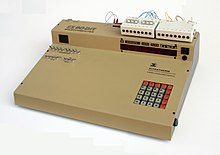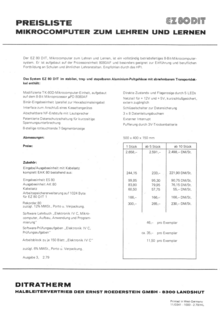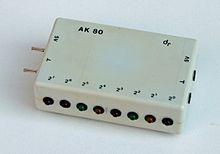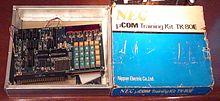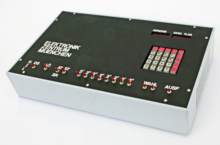EZ80-DIT
The EZ80-DIT microcomputer system was developed in 1977 and used from 1978 as a learning computer in technical training and inter-company training.
The EZ80-DIT consists of a modified version of the NEC - Einplatinencomputers TK-80 (TK: Training Kit). The EZ80-DIT is equipped with the µPD8080A (compatible with the 8-bit microprocessor Intel 8080 ), an eight-digit, seven-segment LED display and a keypad for hexadecimal digits.
The device enables the development and processing of programs in machine language. The system was delivered with a circuit diagram and sample programs, the monitor program.
The additional equipment compared to the single-board computer TK-80:
- Desk-shaped metal housing
- Mains voltage supply for + 12V and + 5V
- binary input switches for operation
- Data backup in the event of a power failure
history
The EZ80-DIT was developed by the Kammerer engineering office in 1977 and manufactured by Roederstein, Landshut until the end of 1982. The distribution was carried out by Ditratherm semiconductor sales GmbH, Landshut. The EZ80-DIT microcomputer was used in the craft training and inter-company training to convey an understanding of the structure and operation of the microcomputer. From 1981 the EZ80-DIT was replaced by the Profi-50 microcomputer system.
General
The system structure can be seen in the adjacent picture. After applying the two supply voltages +12 volts and +5 volts and pressing the reset button, the monitor program starts the functional sequence in the ROM . The monitor program is used to enter data and commands in the memory area of the EZ80-DIT. The read / write memory is designed as a CMOS RAM and is buffered by 2 batteries in the event of a power failure. The negative substrate voltage of −5 volts required for the 8080A microprocessor is generated on the circuit board.
Input-output interface
The input / output takes place via a programmable peripheral interface (µPD8255). This module is used by the system for the cassette interface, the keyboard and switch query as well as by the user for data input via switches and data output via light emitting diodes.
On the back of the EZ80-DIT microcomputer system, the three 8-bit ports of the µPD8255 are brought out via 2mm sockets. The ES80 input unit can be connected to one of the ports to enter binary values. The eight switches of the ES80 unit each generate a TTL-compatible signal that can be read in as a high or low level via a program. The levels of the switch position are indicated by eight red LEDs in the ES80. The AS80 output unit is used to output binary values. The AS80 has eight LEDs that indicate the value of the output port. A traffic light control can be implemented using the different colored LEDs.
Binary input
A switch field with 15 stable toggle switches enables the EZ80DIT system to be controlled via 8 data switches and 7 control switches independently of the keyboard.
Keyboard input
The keypad consists of 25 large keys, 16 keys for hexadecimal input and 9 control keys. The key covers can be removed so that the key field can also be labeled individually. With the exception of the DEL key, any function can be assigned to each key via software. The keyboard is debounced via software. The keypad is queried via the programmable peripheral interface (µPD8255). Two lines of the I / O channels are used for serial data transmission.
Show
Eight red-glowing seven-segment LED displays (10 mm high, 6.5 mm wide, with digital dot) are controlled in a multiplex process to display addresses, commands and data. The display system can also be used to display symbols, alarm signals, acknowledgment displays and fixed and movable fonts via the convenient monitor program. 5 LEDs indicate the flag status, which can also be made visible as a hexadecimal number. A light emitting diode is provided to display the input level for serial data traffic. The operating voltages + 5V and + 12V are also indicated by light emitting diodes.
Data storage
The conversion of serial data into parallel data and vice versa is controlled by the monitor program. The addition of a modulator-demodulator unit allows a standard cassette recorder to be connected. The data transfer speed is 110 bit / s. The cassette recorder can then be used as external storage. It is also controlled via the monitor program.
speaker
Together with the serial input / output, the switch DE switches an audio amplifier with loudspeaker to channel C, connection 2 ^ 1 (port C bit 1). In addition to the function check of a running program, it is also possible to play electronic music, acknowledgment signals or warning signals.
Technical specifications
- CPU µPD8080A
- Clock frequency 2.048 MHz (18.432 MHz crystal)
- ROM area 1024 bytes (max.) 4 µPD464D (256 × 4 bit CMOS)
- RAM area 512 bytes expandable to 1024 bytes (max.) 4 (8) pieces µPD5101-E (256 × 4 bit CMOS)
- Memory access time <800ns
- 8-bit parallel I / O, 3 channels (input and output programmable) µPD8255
- Input via keypad with 25 keys (16 hexadecimal digits, 9 function keys)
- Display via hexadecimal display, 8-digit with 7-segment LED displays
- Serial input / output unit, data rate 110 bit / s
- Operation single step and continuous operation
- Data backup: Short-term data protection in the RAM through electronic switching for up to 15 minutes and additional long-term data protection via 2 dry batteries (2 × 1.5V)
- Power supply + 5VDC ± 5%, 0.9A and + 12VDC ± 5%, 0.15A
- Working range 0 degrees Celsius ... 50 degrees Celsius
- Dimensions 310 × 180mm (circuit board), 500 × 400 × 150 (device in case)
prototype
As early as 1976, a prototype was created and tested by Joseph Kammerer at the Electronics Center in Munich EZM. The device with the dimensions 500 × 300 × 100 mm provided important findings for series production.
literature
- Operating manual EZ80-DIT. Roederstein Group
- Rolf Gräf, Josef Kammerer: Textbook IV C - Microcomputers. 1st edition. Richard-Pflaum-Verlag, Munich 1979, ISBN 3-7905-0285-5 .
Web links
- mrks.de
- IPSJ Computer Museum (NEC TK-80)
- Entry at Oldcomputers.net (NEC TK-80)
- system-cfg.com (NEC TK-80)
- techcn.com.cn (NEC TK-80)
